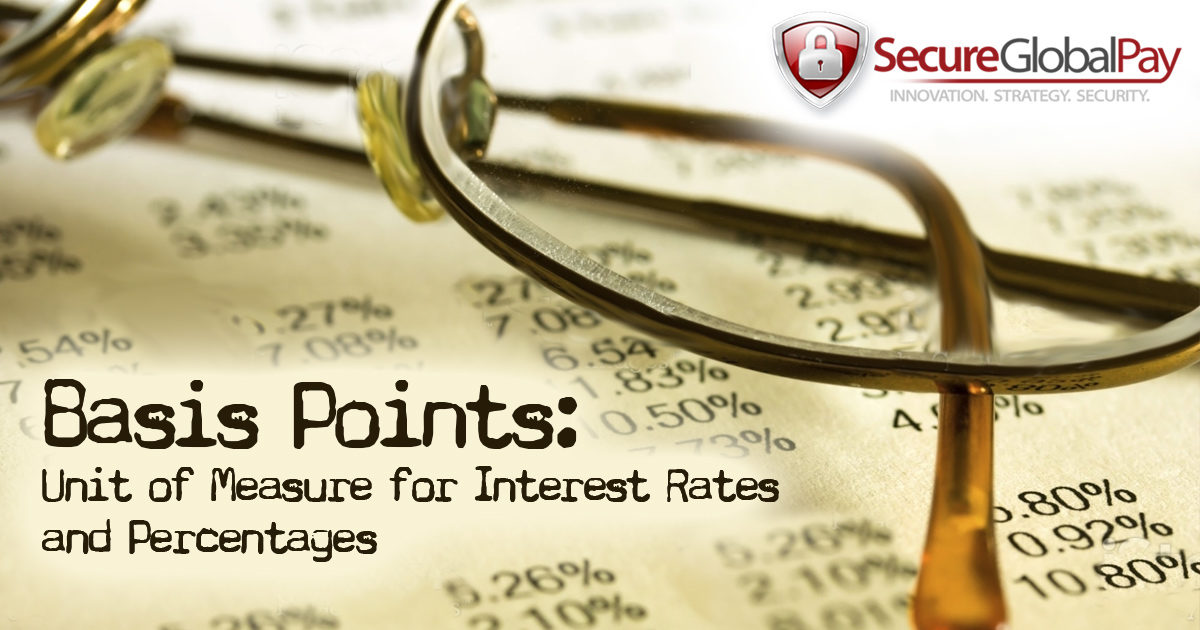
What are Merchant Account Basis Points?
Credit card processing can often be a complicated system of many different card types, interchange pricing, interchange fees, percentage rates, and basis points. In the article below we specifically focus on basis points, also referred to as BPS or Basis Point Percentage. Let us show you how merchant account fees are calculated using basis points. This will especially help in understanding how to read a payment processing statement and how a processor uses basis points to calculate and generate fees for the merchant services provided.
What is a “Basis Point?”
In terms of credit card processing, one basis point is typically 1/100 of one percent. BPS are usually incredibly small percentages. These small numbers and percentages are extremely important to the payment processor and sponsoring bank. They are used to calculate almost every single transaction that has to do with accepting credit cards or non-cash payments in general.
What Are the Basis Points (BPS) Conversion Formulas?
Basis points are typically used when calculating both tiered pricing models and interchange pricing models. However, for each model, they are used in different capacities under different circumstances. Tiered pricing changes can be seen just as often as Interchange BPS adjustments. Understanding the difference is crucial when fees for service are calculated.
When signing up for tiered pricing, your merchant account provider will gather as much information as needed to offer you the best discount rates within the specific tiers, based on your specific business model. The tiers are referred to as, “Qualified”, “Mid Qualified” and “Non Qualified” discount rates.
The primary reason why Interchange BPS changes fluctuate has to do with the cost associated with processing that specific card type. Each credit card transaction has a buy rate associated with it that all banks and processors pay, regardless of their size. If the optimal method of accepting that credit card does not meet the requirements for the lowest discount rate, then your actual BPS will increase and you will end up paying more for that specific credit card transaction.
To understand how basis points are calculated per transaction, you need to understand the particular cost associated with the specific card type being processed. By calculating the number of additional BPS added to a specific card type, you can identify the margins being charged by that particular payment processor. To make things easier, convert the BPS margin to a decimal point and then multiply that number by the dollar volume of transactions processed. This will give you a good idea of what you are paying for the services provided.
Converting BPS to Percentages
To get started you would want to convert the basis point to a decimal as stated above. Keep in mind that one basis point is 1/100 of 1 percent or 0.0001 as a decimal. If your processor charged you a rate of 100 basis points, then you can quickly turn that into a percentage by multiplying 100 by 0.0001 (100 X 0.0001). This would be 0.01 or 1%. This would mean that your processor charges 1% in processing fees.
Converting Percentages to Basis Points
If you want to figure out the BPS calculated for credit card processing, then you simply need to reverse the above formula. For example, if your percentage rate is 1.25%, then you would need to convert that to decimal form. Simply take 1.25% and convert it to 0.0125 simply take 0.0125 (1.25% / 100) and divide by 0.0001 to get 125 BPS.
The term “basis points” may be abbreviated on your merchant account statement as “BP” or “BPS.”
Basis Point Conversion Chart
Now that we’ve explained the formula behind the basis point conversion, we are including an easy-to-read basis point conversion chart.
| BPS | Percentage | Decimal |
|---|---|---|
| 5 | 0.05% | 0.0005 |
| 10 | 0.10% | 0.001 |
| 15 | 0.15% | 0.0015 |
| 25 | 0.25% | 0.0025 |
| 30 | 0.30% | 0.003 |
| 35 | 0.35% | 0.0035 |
| 40 | 0.40% | 0.004 |
| 45 | 0.45% | 0.0045 |
| 50 | 0.50% | 0.005 |
| 55 | 0.55% | 0.0055 |
| 60 | 0.60% | 0.006 |
| 65 | 0.65% | 0.0065 |
| 70 | 0.70% | 0.007 |
| 75 | 0.75% | 0.0075 |
| 80 | 0.80% | 0.008 |
| 85 | 0.85% | 0.0085 |
| 90 | 0.90% | 0.009 |
| 95 | 0.95% | 0.0095 |
| 100 | 1.00% | 0.01 |
How Are Changes in Basis Points Calculated?
BPS are used because the financial industry is always dealing with such small percentages. Rates can vary quite a bit per transaction due to different factors such as non-qualified transactions, mid-qualified transactions, and surcharges that can be added to the qualified rate. Using basis points is an easy way to show different rate changes that are less than one percent.
For example, a payment processor may tag a transaction as a mid-qualified rate. If your mid-qualified transactions rate was + 50 BPS, then the additional rate of 0.50% would be applied to that transaction. This would mean that any transaction that is defined as a mid-qualified rate will be charged 0.50% higher than the qualified rate.
Reasons a Transaction Does Not Meet the Qualified Rate
When your basis points change, it is usually due to the transaction not meeting the qualified rate standards. Reasons this may happen can be due to the following:
The type of credit card used does meet the qualified rate requirements
The credit card being used has been issued by an offshore bank
A transaction batch is not settled within 48 hours
The original sale price of an item does not match the price that was authorized by the merchant account provider
You are unable to match a customer’s address with the address on file through the Address Verification System (AVS).
The magnetic strip on the back of the credit or debit card is not sending completed information to the merchant account provider.
However, there are many other reasons for a transaction to downgrade. Please make sure and consult with your SecureGlobalPay professional so they can help you avoid these costly downgrades.
What If I Have an Interchange Pricing Model?
The interchange pricing model is quite different than the tiered pricing model. The interchange pricing model usually consists of many different fees and percentage rates. This can also include the actual cost associated with that transaction, also called the buy rate. Additionally, you should see the agreed upon basis point and the authorization fees which are paid to your payment processor. The fee is determined either per transaction or by the overall credit card processing volume.
With the interchange pricing model, the rate does not change per transaction. The pricing is usually set by the associations, Visa or MasterCard as well as the financial institution who is processing your credit card payment.
How Do “BPS” Work with the Interchange
Pricing Model?
BPS are still used to calculate the rate per transaction for the Interchange Pricing Model. However, once this rate has been set, then it will stay the same for every transaction. With this model, qualified, mid-qualified, and non-qualified credit card processing rates do not apply.
Please keep in mind that many small businesses are not offered the option of using the interchange pricing model as it is generally available for businesses that do high dollar volume per month.
However, we do see more and more customers who find that interchange pricing works for them. Many businesses like knowing that no matter what type of transaction they are processing the percentage fee and per transaction fee will stay the same.
What Should I Do If Notice My Basis Points Have Increased?
If you notice a problem with the calculations of your basis point fees or your pricing structure in general, then you will want to contact SecureGlobalPay immediately. We can prepare a detailed report that will summarize what card types you are accepting and the reasons associated with the particular fee. This report will help us narrow down the potential pricing problem so that we can help you make the necessary changes to avoid higher fees.





